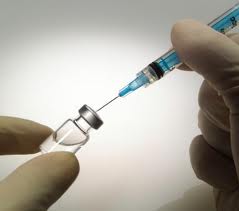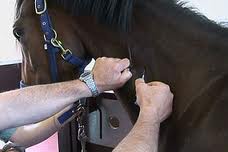|
What you need to know about Equine VaccinationsSide-effects from vaccinations are very rare. Most horse owners give all “spring” shots on one day with little to no negative effects reported. These are recommendations for healthy adult horses who have been vaccinated appropriately in the past.
Equine Vaccination Guideline Horse-riding-connection.com recommends seeking the advice of your local veterinarian for the most appropriate vaccination program and for the diagnosis and treatment of your horse's health problems. For vaccination requirements please contact your state and local licensing authorities. 1. Rabies: Although rabies is infrequent in horses, it is a significant risk to people and is 100% fatal. It is therefore considered a core inoculation. Rabies injection Schedule: Annual booster.

2. Tetanus: Tetanus is a progressive and often fatal disease caused by the bacteria Clostridium tetani, which is ubiquitous in the environment. The disease is caused by a neurotoxin that is produced when the bacteria infects wounds (especially puncture wounds and deep lacerations). It causes progressive “stiff” paralysis that can be fatal if not treated. While the disease is not contagious among horses or people, horses are very sensitive to the neurotoxin and therefore tetanus is considered a core vaccination.
Tetanus injection Schedule: Annually or at the time of a wound or surgery.
3. Eastern Equine Encephalitis/Western Equine Encephalitis: These are neurologic diseases that cause a range of symptoms in horses and people including fever, lethargy, recumbency, seizures, mental dullness and death. They are transmitted by mosquitoes and other blood sucking insects from birds and rodents to horses or humans. They are NOT contagious from horse to horse, human to human or horse to human. The Northeast is considered endemic for these diseases and there have been deaths in horses in the recent past confirmed caused by EEE. The vaccinations available are highly efficacious and very safe.
Eastern/western injection schedule: Annually or bi-annually, depending on risk factors including mosquito prevalence, travel, and time of spring vaccinations.
4. West Nile Virus: West Nile Virus causes neurologic disease similar to EEE and WEE. It is 33% fatal in horse and surviving animals often have long term effects of the disease. Over 24,000 cases since 1999 in US horses. The number of new cases per year in horses continues to decrease. The vaccines available are highly efficacious and very safe.
West nile virus inoculation schedule: Annually or bi-annually, depending on risk factors including mosquito prevalence, travel, and time of spring injections. NOTE: EEE/WEE, Tetanus and West Nile Virus is a combined vaccine product that is used regularly.
5. Herpes/Rhinopneumonitis: Rhino is caused by Equine Herpes Virus (EHV). It is divided in to subtypes EHV-1 and EHV-4. It causes a variety of clinical disease, including abortion, weak or stillborn foals, acute neurologic disease and upper respiratory disease. This disease group has been very controversial in the last several years due to neurologic outbreaks. It is highly contagious from horse to horse via nasal secretions and can live in the environment for at least 14 days. The vaccinations do NOT protect against the neurologic form of the disease. However, the preparation may help reduce spread of the disease from horse to horse.
Herpes/Rhinopneumonitis inoculation Schedule: Bi-annually Due to the highly contagious nature of the disease, and the fact that the vaccine may not provide long-lived protection.

6. Influenza: Influenza causes similar signs to human flu. High fevers, lethargy, nasal discharge, cough. Influenza has many strains and sometimes the vaccine doesn't protect against them all. The vaccine is only protective for 4-6 months. It is highly contagious and is most common in horses that travel a lot and are exposed to new horses, or at show grounds, race-tracks, etc.
Influenza vaccine Schedule: Bi-annually is recommended, or more often if travelling and showing frequently. NOTE: Influenza comes in a combination vaccine with Rhino. (Flu/Rhino)
7. Potomac Horse Fever: Caused by Neorickettsia risticii (formerly Ehrlichia risticii), this disease has a complex lifecycle, including snails and slugs. It is believed to be transmitted to horses through accidental ingestion of insects (mayflies, caddis flies, aquatic insects) who have ingested the organism in water. It is therefore more common in areas with water, snails, and aquatic insects. The disease is seasonal, worse in summer months, and is more common in areas South of Maine. However, recently there have been several suspicious cases in Maine. Clinical signs include fever, diarrhea, lethargy, colic, and laminitis. Unfortunately, the disease is often fatal. The vaccine has variable efficacy and is not known to have long lasting immunity.
Potomac Horse Fever vaccination Schedule: Annually or bi-annually for horses in high risk areas or horses that are traveling South.
8. Strangles: Caused by a bacteria, Streptococcus equi, strangles is characterized by high fever, thick mucopurulent nasal discharge (mucous and pus) and swelling and abscessing of the lymph nodes of the head and upper throat. The organism is persistent in the environment and is highly contagious from horse to horse. There are two types of vaccines. One is injectable (intramuscularly) and one is intranasal (squirted up the nose). Because of the different methods that these vaccines create immunity, they are not interchangeable. In other words, if your horse was previously vaccinated with the injectable form, then switching to the intranasal form would require an initial series of two vaccines.
Strangles vaccine Schedule: Annually. Recommended for horses that travel, show or live in barns that have horses coming in and out on a regular basis.
Giving an injection for the first time can be a little nerve-racking, but with practice it gets easier. Horses feel far less pain then humans do from vaccinations. Most vaccines are given intramuscularly (IM) in the neck or hip. Injections can also be given subcutaneously (SQ) or intravenously (IV). Subcutaneous injections are given under the skin but not in the muscle. Intravenous injections are given directly into a vein.
In preparation to administer an injection, do the following:
1.Shake vial for a few seconds to mix well, if required.
2.Tighten the needle on the syringe. Pull back on syringe and insert needle into vial. Push air into vial.
3.Pull the syringe plunger back and draw the desired amount of vaccine into the syringe.
4.Turn the vial over and remove the needle from the via How to give an IM injection:
Most vaccinations may be given IM in the neck of the horse. For this procedure, remove the needle from the syringe, making sure to hold it by the plastic end. Hold the needle between your thumb and index finger. Use the heel of your hand to pat the horse's neck a couple of times, and on the third pat insert the needle in the neck. Attach the syringe to the needle, pull back slightly on the syringe plunger to make sure that in the needle is not in a blood vessel (if it is, blood will enter the syringe as you pull back the plunger), then administer the vaccine. When the needle is removed, rub the injection site slightly and then observe for any bleeding. If any bleeding occurs, apply pressure until the bleeding stops.
SQ injections are given just beneath the skin. Simply lift the skin on the neck, insert the needle, pull back slightly on the syringe plunger to be sure the needle is not in a blood vessel (if it is, blood will enter the syringe as you pull back the plunger), and then administer the vaccine. Use needles and syringes only once With any vaccine or injectable medication, always use a separate sterile needle and syringe for each injection.
|
